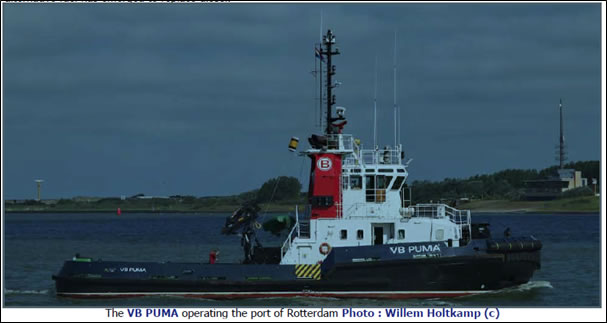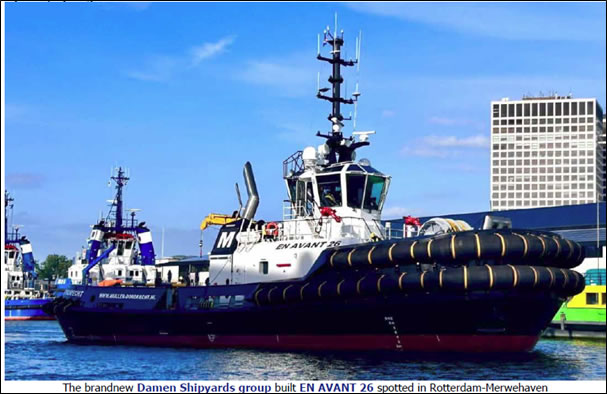

DOSSIER
- Welcome
Accueil - Nieuws
Nouvelles- 25/10 U.S. woman reportedly dead, 5 rescued after Viking ship replica sinks off Norway
- 27/10 Shipping industry nears 100-installation milestone of wind propulsion systems
- 30/10 World's biggest underwater methane hotspot is found off Barents Sea coast
- 01/11 Hong Kong keeps Russia’s dark fleet afloat
- 03/11 Shipowners Who Force Seafarers To Sail High-Risk Areas May Face Sanctions
- 07/11 Primeur grootste convertor golfenergie ter wereld komt uit Europa
- 09/11 Helibeloodsing lijkt weer mogelijk, mits extra partners
- 12/11 Pirates, Middle East instability and drought disrup the world’s ports
- 14/11 Russia Still Second Largest Gas Provider to EU, After Norway, with LNG Imports Increasing
- 16/11 Megaship deliveries likely to impact profits: agency
- 19/11 P&O Ferries ziet Zeebrugge-Tilbury verstoord door tekort beloodsing
- 21/11 Wallenius Wilhelmsen bestelt vier recordschepen voor 11.700 auto's
- 23/11 Flanders Ship Repair verhuist naar militair beveiligde nieuwbouw
- Kalender Calendrier
- BML Nieuws
LMB Nouvelles - Historiek
Historique- 28/10 Declining and rising empires: Venice, the Ottomans and Spain
- 04/11 Declining and rising empires: Venice, the Ottomans and Spain(II)
- 11/11 Les Mutiniers de la flotte anglaise 1797
- 18/11 De schipbreuk van de kotter Princess of Wales en de schoener l'Aventure (I)
- 25/11 De schipbreuk van de kotter Princess of Wales en de schoener l'Aventure (II)
- Dossier
Dossier
- 24/10 The indispensability of the Greek-owned fleet: international and cross-trading
- 26/10 Confirmation on use of standard terms
- 29/10 Port State Control – Be prepared for new campaigns and restrictions
- 31/10 Navigating the new normal: Vessel rerouting spurs higher emissions as ships avoid the Red Sea
- 02/11 BIMCO: Tanker Shipping Demand to Rise by 10.2% in 2024, Compared to 2022 Supply/demand balance
- 05/11 Project Lotus to provide transparent ownership cost
- 08/11 Shipping supply chains and global conflicts
- 10/11 Time to look beyond diesel: the decarbonisation pathway for tugs
- 13/11 Pirates, Middle East instability and drought disrup the world’s ports
- 15/11 Tankers: Peak Demand is Coming, But Cargoes Will Still Be Plenty
- 17/11 Red Sea diversions and slower ports cause bigger-than-expected issues – will they last?
- 20/11 Energie-eiland levert DEME, Jan De Nul en Smulders miljardendeal op
- 22/11 New survey findings shed light on the impact of decarbonisation on seafarers’ wellbeing
- 24/11 Red Sea gives shipping an Uber-style price surge
- Untitled Item
- Raad
Comité - Verenigingen
Associations - Contacten
Contacts - Links
Liens - Boeken
Livres - Archives
Archieven- Archieven 1 - Archives 1
- Archieven 2 - Archives 2
- Archieven 3 - Archives 3
- Archieven 4 - Archives 4
- Archieven 5 - Archives 5
- Archieven 6 - Archives 6
- Archieven 7 - Archives 7
- Archieven 8 - Archives 8
- Archieven 9 - Archives 9
- Archieven 10 - Archives 10
- Archieven 11 - Archives 11
- Archieven 12 - Archives 12
- Archieven 13 - Archives 13
- Archieven 14 - Archives 14
- Archieven 15 - Archives 15
- Archieven 16 - Archives 16
- Archieven 17 - Archives 17
- Archieves 18 Archieven 18
- Photos
Foto's
Time to look beyond diesel: the decarbonisation pathway for tugs
John Snyder
Biofuels, methanol, hydrogen and electrification highlighted as promising pathways to IMO emissions targets but no easy answers for owners, with some 20,000 diesel-powered tugs in the global fleet
Biofuels, methanol, electrification, crew training and underwater-radiated noise were at the centre of a compelling discussion held by tug owners, designers and engine manufacturers addressing environmental sustainability in tug operations.
Joining in the discussion on decarbonisation and future fuels were executives from leading tug owners Svitzer, Smit Lamnalco and Boluda Towage Europe, naval architectural firm Robert Allan Ltd and enginebuilder Caterpillar Marine. During the session at Riviera’s ITS 2024 in Dubai on 21 May, delegates heard some powerful and practical insights about alternative fuels, tug hybridisation and electrification gained from real-world operational, design and construction experience. Weighing on the minds of presenters and delegates alike are the challenges of meeting IMO’s aspirational greenhouse gas (GHG) reduction targets over the next 25 years. While there is growing confidence in the maritime industry that it can reduce GHG emissions by 20% striving for 30% by 2030, there is much less faith that a 70% striving for 80% reduction in GHG emissions can be reached by 2040, and net-zero by 2050.
Cannot build out of it
To move the needle on GHG and CO2 emissions reduction, the existing global fleet of 20,000+ diesel-powered tugs will have to be dealt with, either replaced or retrofit. That’s a particularly daunting task, noted Svitzer group head of technical innovation, Thomas Bangslund, given the limited available shipyard capacity. Further complicating the picture is that much like the offshore support vessel market, the global tug sector is highly fragmented and dominated by small, privately held owners. This makes financing problematic. And to add to the complexity of the challenge, no single alternative fuel has emerged to replace diesel.
“We cannot just build our way out,” concluded Mr Bangslund, adding, “We must do what we can with the assets we have now.”
For Svitzer, with some 452 tugs of its own operating in 120 ports worldwide, this means testing biofuels, methanol, hydrogen and retrofitting existing tugs. The vessel owner wants to reach a 50% reduction in carbon intensity for its fleet by 2030, and climate neutrality as an organisation by 2050.
Mr Bangslund was open and eager to share the three principal levers of Svitzer’s strategy for helping attain its sustainability goals – namely, behaviour, fuels and equipment. Notable was the importance of the behaviour of the master and crew in supporting the company’s decarbonisation journey and applying known technology “in a different way.” As an example, he cited the TRAnsverse Tug design from Robert Allan Ltd, which he called “a game changer” because of its ability to generate higher steering forces than comparable designs, while still saving fuel.
He also discussed the potential for electric-hybrid tug retrofits, replacing an existing inefficient small genset with a battery.
Delegates, however, were anxious to hear about Svitzer’s experience with biofuels, including using hydrotreated vegetable oil (HVO) in 70 tugs in the UK, and more recently its trials with fatty acid methyl ester (FAME), referred to as biodiesel.

“We are dipping our toes into FAME,” said Mr Bangslund, who characterised the trials of FAME B100 in the tug Svitzer Lynx as “successful”. Overall, the tug accumulated 1,000 hours, burning 100 m3 of FAME.
Areas of caution in handling FAME flagged up by Svitzer’s crews are its lack of smell and colour, making it more difficult to detect fuel leaks. Additionally, biodiesel is prone to biological growth, increasing the possibility of filter clogging. As a solution, Svitzer took a proactive approach, changing fuel filters prior to the trials and every 250 running hours.
More training
Smit Lamnalco global director, LNG business and project development, Andy Brown warned that transitioning to ammonia, hydrogen and methanol will require more training for crew, and more research was needed into the potential long-term health effects of exposure to these new low- and zero-carbon fuels. He highlighted the potential risks of ammonia slip and loss of containment.
Smit Lamnalco operates a fleet of harbour and terminal tugs. Owned jointly by Boskalis and the Rezayat Group, Smit Lamnalco supports a floating storage, regasification unit as part of the Hong Kong Floating LNG project with LNG-fuelled tugs.
“We need a new safety culture,” warned Mr Brown, noting this will require a new maritime curriculum to be taught. “We are not training people on alternative fuels” at maritime colleges, he observed.One effort in this area he highlighted is a collaboration between the International Bunker Industry Association and BIMCO on training and education on new fuels and bunkering. A memorandum of understanding signed between the parties in April considers the development of joint training programmes and educational initiatives to boost the knowledge of maritime professionals in the maritime and bunkering sectors.

Hybrids, hydrogen and biofuels
It has been more than a decade since Boluda Towage converted its first tug for battery-hybrid operation. This was followed two years later with an order for two battery-hybrid newbuilds, tests of biofuel in 2018, retrofit of a tug with an IMO Tier III engine in 2020, four IMO Tier III newbuild tugs in 2021, and the H2 Tugboat project, a feasibility study on the hydrogen-fuelled tug in 2022.
Undertaking a battery-hybrid conversion is “like putting an elephant in a shoebox,” said Boluda Towage Europe chief executive Geert Vandecappelle.Like the other vessel owners, Mr Vandecappelle highlighted the critical role mariners can play in a company’s decarbonisation journey. He said it was important to make the crew aware of how they are sailing and support their decision-making with tools such as fuel monitoring systems to allow for fuel consumption optimisation.
Boluda Towage has refit 17 tugs with the fuel monitoring systems, yielding fuel savings of 1,281,909 litres of fuel and a 10% reduction in CO2 emissions. He called fuel consumption monitoring “low-hanging fruit. «Mr Vandecappelle also raised important considerations about operations and maintenance with biodiesels and the commercial implications of investing in an all-electric tug. «How many types of biodiesel can you mix? How many filters will you need?” he asked. “An electrical tug: where are you going to charge it?” also noting some of the challenges of deploying such tugs for certain jobs.
But Boluda’s roadmap to carbon neutrality will include electrical, methanol and hydrogen as power sources. Caterpillar Marine is one of the four-stroke engine builders that firmly believes in methanol, biofuels and electrification. It has plans to install its first 3516E methanol dual-fuel engines in a tug in 2026. While noting the advances in tug design over the last 100 years since the diesel-powered James W took to the water in 1923, Caterpillar Marine global marine technology steward, Marinus Jensen said it was “time to look beyond diesel.”
Mr Jensen noted almost half of the global tug fleet based on installed power was built since 2008. This means the tug and towage industry is somewhat challenged to meet IMO’s ambitious environmental goals, he said.
“I believe the energy transition needs a little more inclusivity and a little more diversity.” Tugs using biofuels, methanol, synthetic diesel and electric propulsion will develop in parallel and in competition. “Our sustainability journey is a learning journey, where we share our knowledge,” said Mr Jensen. He said while an owner might start his decarbonisation pathway “all in” on biofuels, he might have to pivot to another fuel or technology as it emerges. Maintaining that flexibility is important. «Engineering is not a fairy tale and there are no unicorns,” he concluded.
Source : Riviera Maritime Media
LMB-BML 2007 Webmaster & designer: Cmdt. André Jehaes - email andre.jehaes@lmb-bml.be